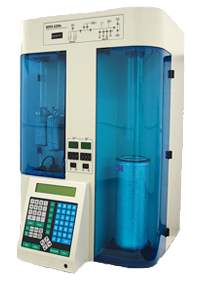Surface Area

Surface area and porosity are important physical properties that influence the quality and utility of many materials and products. Therefore it is critically important that these characteristics be accurately determined and controlled.
Surface area helps determine such things as how solids burn, dissolve, and react with other materials. To determine the surface area, solid samples are pre-treated by applying some combination of heat, vacuum, and /or flowing gas to remove adsorbed contaminants acquired (typically water and carbon-dioxide) from atmospheric exposure.
If this is not done, the surface area result may be low and non-reproducible since an indeterminate amount of the surface will be covered with these materials. This step must be done with care as it is possible that excessive heat may change the surface of the material or effect the integrity of the sample which will have a direct effect on the surface area results.
The samples are then weighed and placed onto the instrument for analysis. The solid is cooled, under vacuum, usually to cryogenic temperature (77 k, -195 °C). An adsorptive gas (escubed uses nitrogen) is dosed to the solid in controlled increments. After each dose of nitrogen, the pressure is allowed to equilibrate and the quantity adsorbed is calculated. The quantity adsorbed at each pressure (and temperature) defines an adsorption isotherm, from which the quantity of gas required to form a monolayer over the external surface of the solid is determined. With the area covered by each adsorbed gas molecule known, the surface area can be calculated.
Porosity, Pore Sizes and Pore Distributions
Surface area determinations involve creating the conditions required to adsorb an average monolayer of molecules onto a sample. By extending this process so that the gas is allowed to condense in the pores, the sample’s fine pore structure can be evaluated. The pressure is increased until saturation is reached, at which time all pores are filled with liquid. The adsorptive gas pressure then is reduced incrementally, evaporating the condensed gas from the system. Evaluation of the adsorption and desorption branches of these isotherms and the hysteresis between them reveals information about the size, volume, and area.
Lawson Scientific measures Specific Surface Area using a Quantachrome Nova 2000e which uses the Brunauer-Emmett-Teller (BET) equation to describe the Surface Area and Barrett-Joyner-Halenda (BJH) equation to calculate the pore size and volume. This method is in accordance with BS ISO 9277:2010 – Determination of the specific surface area of solids by gas adsorption — BET method.
We provide;
Single- and multipoint BET surface area
Total pore volume
Langmuir surface area and isotherm reports
BJH adsorption and desorption average pore diameter (4V/A) determinations
Mesopore and Macropore – Volume and area distributions by pore size
BET Specific Surface Area, pore size and distribution data (BJH) is useful across many sectors and industries including;
Pharmaceutical
Agrochemical
Additives
Materials
Chemicals
Nanotechnology
Ceramics
Pigments
 +44 (0)1582 704807
+44 (0)1582 704807 enquiries@lawsonscientific.co.uk
enquiries@lawsonscientific.co.uk


